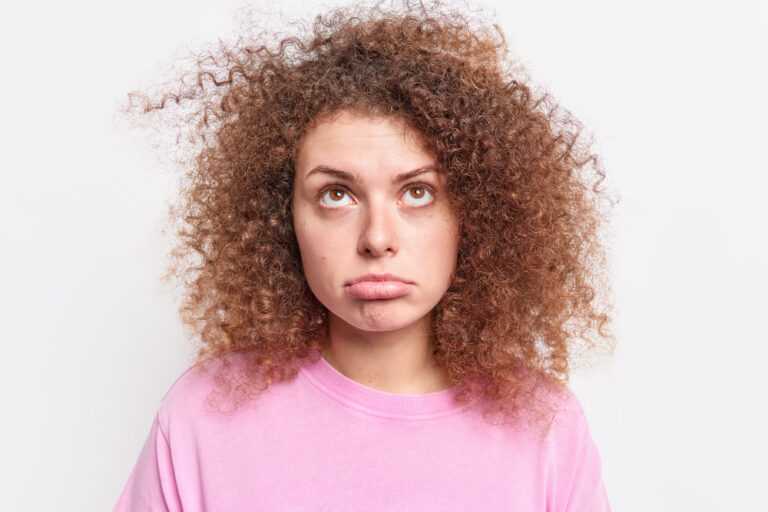It’s so frustrating when it feels like your hair just won’t grow.
My friend recently got her hair cut and it was a disaster.
She’d been so eager to grow out her bad haircut. About 2 months later, she was asking me why her hair wasn’t growing.
And that’s why I decided to write this post.
You see other people with long, healthy strands, and meanwhile, your hair stays the same length no matter what you do.
If you’ve been wondering why your hair isn’t growing, this post is for you.
Hair growth isn’t just about genetics.
It does play a part, yes. But it’s not everything.
A lot of everyday habits and lifestyle choices can slow it down without you even realizing it.
If you’ve been struggling to grow your hair past a certain point, one of these reasons might be the culprit.
Please note that this post contains affiliate links. If you click a link and make a purchase, I will make a commission at no extra cost to you.
Let’s dive in!
1. You’re Not Getting Enough Nutrients
Hair growth starts from the inside.
If your body isn’t getting enough vitamins and minerals, your hair won’t have what it needs to grow properly.
Low levels of iron, biotin, zinc, and protein can lead to thinning and slow growth.
It sucks, but it’s the truth.
So, what I suggest is eating more nutrient-rich foods like eggs, nuts, leafy greens, and salmon.
Now, if you’re not able to do this, then consider taking a hair-friendly supplement with biotin and collagen.
This one really helped my friend so it’s tried and tested!
2. You Have Too Much Product Buildup
Heavy styling products, oils, and dry shampoo can build up on your scalp, clogging hair follicles and slowing down growth.
If your scalp isn’t clean, your hair can’t grow properly.
Use a clarifying shampoo once a week to remove buildup.
If you use a lot of styling products, wash your hair more frequently to keep your scalp fresh and clean.
3. You’re Not Trimming Your Hair
It sounds counterintuitive, but split ends can actually prevent hair growth.
What happens is, the split ends rise up and damage the rest of the healthy hair. This slows down hair growth.
When hair becomes damaged, it starts breaking off at the ends, making it seem like it’s not growing at all.
So, please get a trim every 8-12 weeks to prevent split ends from traveling up the hair shaft.
If you want to grow your hair long, ask your stylist for a “dusting” instead of a full trim to keep as much length as possible.
I always tell my hairstylist Shane to cut my hair in such a way that it grows!
4. Your Scalp is Unhealthy
A healthy scalp is the foundation for healthy hair.
If your scalp is dry, irritated, or full of product buildup, it can slow down hair growth. Conditions like dandruff, psoriasis, or too much oil production can all impact how fast your hair grows.
Give your scalp extra love by massaging it regularly to increase circulation. Use a scalp scrub or tea tree oil to remove buildup and soothe irritation.
Moreover, make sure you keep a check on the foods you’re eating and whether you’re staying hydrated.
5. You’re Using Too Much Heat
Heat styling damages the hair shaft, making it weaker and more prone to breakage.
If your hair keeps breaking off, it will never get longer, no matter how fast it grows.
Try to air dry your hair as much as possible and use heat tools only when necessary. When you do use them, always apply a heat protectant spray to minimize damage.
This is the only one that has actually worked for my hair.
6. You’re Washing Your Hair Too Often
Aye, a mistake I used to make so much before!
I lived in a tropical city, so I used to wash my hair every day after work.
But I didn’t know how much damage I was causing!
Frequent washing strips your hair of natural oils, which are essential for keeping it strong and moisturized. Dry, brittle hair snaps easily, which makes it seem like it’s not growing.
Try washing your hair every 2-3 days instead of daily.
If your scalp gets oily fast, use a lightweight dry shampoo in between washes.
7. You’re Not Drinking Enough Water
Hydration plays a huge role in hair health.
This is something I tell everyone. It’s so easy to overlook how much water we’re drinking because we’re so preoccupied with work and chores, but please don’t forget to drink water!
If you’re dehydrated, your hair will be dry, brittle, and more likely to break off before it gets a chance to grow long.
Make sure you’re drinking at least 8 glasses of water a day. Eating water-rich foods like cucumbers, watermelon, and oranges can also help keep your hair hydrated from the inside out.
8. You’re Wearing Tight Hairstyles Too Often
Constantly wearing your hair in tight ponytails, buns, or braids puts stress on your hair follicles, leading to breakage and even hair loss over time.
How to fix it: Switch to loose, protective hairstyles that don’t pull on your scalp. Use soft hair ties instead of tight elastics to avoid unnecessary tension.
9. You’re Sleeping on the Wrong Pillowcase
Cotton pillowcases absorb moisture from your hair and create friction while you sleep, leading to dryness and breakage.
How to fix it: Swap your cotton pillowcase for a satin or silk pillowcase to help your hair stay smooth and hydrated overnight.
10. You’re Not Using the Right Hair Products
If you’re using products that contain sulfates, alcohol, or harsh chemicals, they could be stripping your hair of moisture and causing breakage.
How to fix it: Check your hair product labels and avoid anything with sulfates, parabens, or drying alcohols. Look for nourishing ingredients like argan oil, shea butter, and keratin instead.
11. Your Hair Growth Cycle is Stuck
Hair goes through different growth phases—and sometimes, it gets stuck in the resting phase, where it doesn’t grow much at all. This can be triggered by stress, hormonal changes, or age.
How to fix it: Reduce stress with meditation, exercise, or better sleep habits. If you suspect a hormonal imbalance, talk to a doctor about possible solutions like supplements or dietary changes.
Hair growth takes time, but with the right care, you can help your hair reach its full potential. Which of these habits do you need to change? Let me know in the comments!



